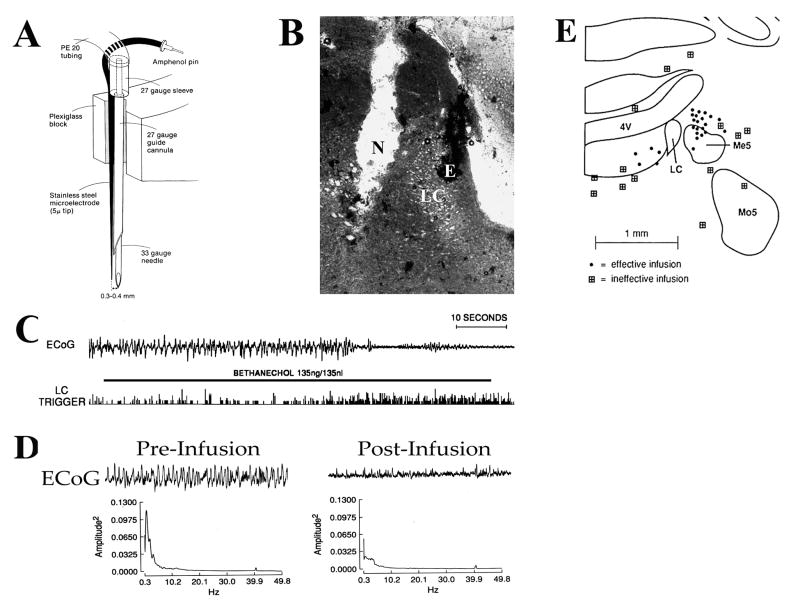Figure 1.
Effects of LC activation on cortical EEG (ECoG) activity state. For these studies, the LC was first located electrophysiologically using a combined recording-infusion probe in the halothane-anesthetized rat. Once located, a 100–150 nl infusion of the cholinergic agonist, bethanechol, was made adjacent to the LC to activate LC neurons while simultaneously recording LC discharge activity. The effect of infusion-induced activation of the LC on ECoG (and hippocampal EEG, not shown) was monitored. A: Schematic of the infusion/recording probe used to activate LC. Bethanechol was infused 300–400 μm lateral or medial to the recording electrode that was used to locate the main body of the LC. B: Photomicrograph of a peri-LC infusion site. In this example, an infusion lateral of the LC is depicted. N indicates position within the track created by the infusion needle where the infusate exited the needle. E indicates position of the recording electrode within the LC. C: Simultaneous effects of bethanechol infusion on LC activity (LC Trigger, bottom trace) and ECoG activity (top trace). Bethanechol infusion (indicated by horizontal bar) increased LC discharge rate approximately two-thirds of the way through the 60-second infusion. Several seconds following LC activation, EEG desynchronization is observed. EEG recordings were ipsilateral to the manipulated LC. However, identical effects were observed in the contralateral hemisphere. D: Power spectral analyses of 11-second pre-infusion and post-infusion ECoG epochs. Power of low-frequency activity is decreased following bethanechol-induced activation of ECoG. E: Schematic depicting bethanechol infusion sites that were effective or ineffective for activating forebrain EEG. Solid circles indicate sites at which bethanechol infusion activated EEG. Shaded boxes indicate sites at which bethanechol infusion had no obvious EEG effects. There is a radius of approximately 500 μm around LC within which infusions, placed either medially or laterally, activated forebrain EEG. Infusions placed immediately anterior to the LC were also ineffective (not shown). These mapping studies strongly argue against drug action at other arousal-related brainstem nuclei (e.g. cholinergic, serotonergic). Abbreviations: Me5, mesencephalic nucleus of the trigeminal nerve; Mo5, motor nucleus of the trigeminal nerve; Pr5, principle sensory nucleus of the trigeminal nerve; 4V, fourth ventricle (from22).

